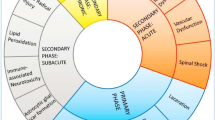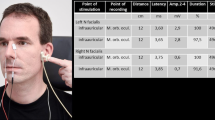Abstract
Background
Improvement of transcranial electrical motor-evoked potentials (TeMEPs) following untethering during tethered cord surgery (TCS) and its clinical significance have not been analyzed in the literature.
Methods
Forty-five consecutive cases of tethered cord were operated on with multimodality intraoperative neurophysiological monitoring (IONM) between February 2005 and January 2012. Intraoperative TeMEP change was classified as improvement, worsening or no change. Motor, sensory, bladder and bowel symptoms and signs were evaluated preoperatively, in the first week post-surgery and at the last follow-up (maximum of 2 years).
Results
Patient age ranged from 5 to 44 years (mean, 16 ± 10 years), with 30 children. Intraoperative MEPs improved in 23 (51 %), remained the same in 21 (46.7 %) and worsened in 1 (2 %) patient. Motor improvement occurred in 7 patients and clinical improvement in 17 patients in the immediate postoperative period. Postoperative neurological worsening occurred in one patient (2.2 %). Improved and stable MEPs correlated with the motor (p = 0.002) and clinical improvement (p = 0.02) in the immediate postoperative period. Follow-up was available in 35 patients (77.7 %), ranging from 5 to 24 months (median, 21 months; mean, 17.7 ± 6.8 months). There was late clinical improvement in 73.5 % of the patients in whom the intraoperative MEP had remained the same or improved. However, there was no statistically significant correlation between MEP change and long-term outcome.
Conclusions
Intraoperative MEP improvement occurs in about 50 % of the patients following successful untethering. This finding probably provides support to the ischemic theory of tethered cord syndrome.




Similar content being viewed by others
Abbreviations
- TeMEP:
-
Transcranial electrical motor-evoked potential
- TCS:
-
Tethered cord surgery
- IONM:
-
Intraoperative neurophysiological monitoring
- EMG:
-
Electromyography
- MEP:
-
Motor-evoked potential
- MRI:
-
Magnetic resonance imaging
- SSEP:
-
Somatosensory-evoked potential
- MRC:
-
Medical Research Council
- CMAP:
-
Compound muscle action potential
References
Albright AL, Pollack IF, Adelson PD, Solot JJ (1999) Outcome data and analysis in pediatric neurosurgery. Neurosurgery 45:101–106
Al-Holou WN, Muraszko KM, Garton HJ, Buchman SR, Maher CO (2009) The outcome of tethered cord release in secondary and multiple repeat tethered cord syndrome. J Neurosurg Pediatr 4:28–36
Beyazova M, Zinnuroglu M, Emmez H, Kaya K, Ozkose HZ, Baykaner MK, Erden Z, Orucoglu N, Ozturk GT, Erdogan Z (2010) Intraoperative neurophysiological monitoring during surgery for tethered cord syndrome. Turk Neurosurg 20:480–484
Chen X, Sterio D, Ming X, Para DD, Butusova M, Tong T, Beric A (2007) Success rate of motor evoked potentials for intraoperative neurophysiologic monitoring: effects of age, lesion location, and preoperative neurologic deficits. J Clin Neurophysiol 24:281–285
Fulkerson DH, Satyan KB, Wilder LM, Riviello JJ, Stayer SA, Whitehead WE, Curry DJ, Dauser RC, Luerssen TG, Jea A (2011) Intraoperative monitoring of motor evoked potentials in very young children. J Neurosurg Pediatr 7:331–337
Hilibrand AS, Schwartz DM, Sethuraman V, Vaccaro AR, Albert TJ (2004) Comparison of transcranial electric motor and somatosensory evoked potential monitoring during cervical spine surgery. J Bone Joint Surg Am 86-A:1248–1253
Hoving EW, Haitsma E, Oude Ophuis CM, Journée HL (2011) The value of intraoperative neurophysiological monitoring in tethered cord surgery. Childs Nerv Syst 27:1445–1452
Husain AM, Shah D (2009) Prognostic value of neurophysiologic intraoperative monitoring in tethered cord syndrome surgery. J Clin Neurophysiol 26:244–247
James HE, Mulcahy JJ, Walsh JW, Kaplan GW (1979) Use of anal sphincter electromyography during operations on the conus medullaris and sacral nerve roots. Neurosurgery 4:521–523
Khealani B, Husain AM (2009) Neurophysiologic intraoperative monitoring during surgery for tethered cord syndrome. J Clin Neurophysiol 26:76–81
Kothbauer K, Schmid UD, Seiler RW, Eisner W (1994) Intraoperative motor and sensory monitoring of the cauda equina. Neurosurgery 34:702–707
Kothbauer KF, Deletis V (2010) Intraoperative neurophysiology of the conus medullaris and cauda equina. Childs Nerv Syst 26:247–253
Kumar GS, Rajshekhar V, Babu KS (2006) Intraoperative mapping of sacral nervous system (S2-4). Br J Neurosurg 20:396–402
Lang EW, Beutler AS, Chesnut RM, Patel PM, Kennelly NA, Kalkman CJ, Drummond JC, Garfin SR (1996) Myogenic motor-evoked potential monitoring using partial neuromuscular blockade in surgery of the spine. Spine 21:1676–1686
Lew SM, Kothbauer KF (2007) Tethered cord syndrome: an updated review. Pediatr Neurosurg 43:236–248
Lieberman JA, Lyon R, Feiner J, Diab M, Gregory GA (2006) The effect of age on motor evoked potentials in children under propofol/isoflurane anesthesia. Anesth Analg 103:316–321
Paradiso G, Lee GY, Sarjeant R, Hoang L, Massicotte EM, Fehlings MG (2006) Multimodality intraoperative neurophysiologic monitoring findings during surgery for adult tethered cord syndrome: analysis of a series of 44 patients with long-term follow-up. Spine 31:2095–2102
Phillips LH 2nd, Jane JA (1996) Electrophysiologic monitoring during tethered spinal cord release. Clin Neurosurg 43:163–174
Pouratian N, Elias WJ, Jane JA Jr, Phillips LH 2nd, Jane JA Sr (2010) Electrophysiologically guided untethering of secondary tethered spinal cord syndrome. Neurosurg Focus 29:E3
Quiñones-Hinojosa A, Gadkary CA, Gulati M, von Koch CS, Lyon R, Weinstein PR, Yingling CD (2004) Neurophysiological monitoring for safe surgical tethered cord syndrome release in adults. Surg Neurol 62:127–133, discussion 133–135
Rajshekhar V, Velayutham P, Joseph M, Babu KS (2011) Factors predicting the feasibility of monitoring lower-limb muscle motor evoked potentials in patients undergoing excision of spinal cord tumors. J Neurosurg Spine 14:748–753
Sala F, Krzan MJ, Deletis V (2002) Intraoperative neurophysiological monitoring in pediatric neurosurgery: why, when, how? Childs Nerv Syst 18:264–287
Schneider SJ, Rosenthal AD, Greenberg BM, Danto J (1993) A preliminary report on the use of laser-Doppler flowmetry during tethered spinal cord release. Neurosurgery 32:214–217, discussion 217–218
Shinomiya K, Fuchioka M, Matsuoka T, Okamoto A, Yoshida H, Mutoh N, Furuya K, Andoh M (1991) Intraoperative monitoring for tethered spinal cord syndrome. Spine 16:1290–1294
Tanaka S, Tashiro T, Gomi A, Takanashi J, Ujiie H (2011) Sensitivity and specificity in transcranial motor-evoked potential monitoring during neurosurgical operations. Surg Neurol Int 2:111
von Koch CS, Quinones-Hinojosa A, Gulati M, Lyon R, Peacock WJ, Yingling CD (2002) Clinical outcome in children undergoing tethered cord release utilizing intraoperative neurophysiological monitoring. Pediatr Neurosurg 37:81–86
Yamada S, Zinke DE, Sanders D (1981) Pathophysiology of “tethered cord syndrome. J Neurosurg 54:494–503
Yamada S, Won DJ, Yamada SM (2004) Pathophysiology of tethered cord syndrome: correlation with symptomatology. Neurosurg Focus 16:E6
Acknowledgments
The authors thank Ms. Visali Jayaseelan, Department of Biostatistics, for helping with the statistical analysis. The authors also thank Mr. Benjamin Franklin and Ms. Delhi Rani for technical help in monitoring the patients and electrophysiological data collection.
Conflicts of interest
None.
Author information
Authors and Affiliations
Corresponding author
Rights and permissions
About this article
Cite this article
Pratheesh, R., Babu, K.S. & Rajshekhar, V. Improvement in intraoperative transcranial electrical motor-evoked potentials in tethered cord surgery: an analysis of 45 cases. Acta Neurochir 156, 723–731 (2014). https://doi.org/10.1007/s00701-014-1999-7
Received:
Accepted:
Published:
Issue Date:
DOI: https://doi.org/10.1007/s00701-014-1999-7




